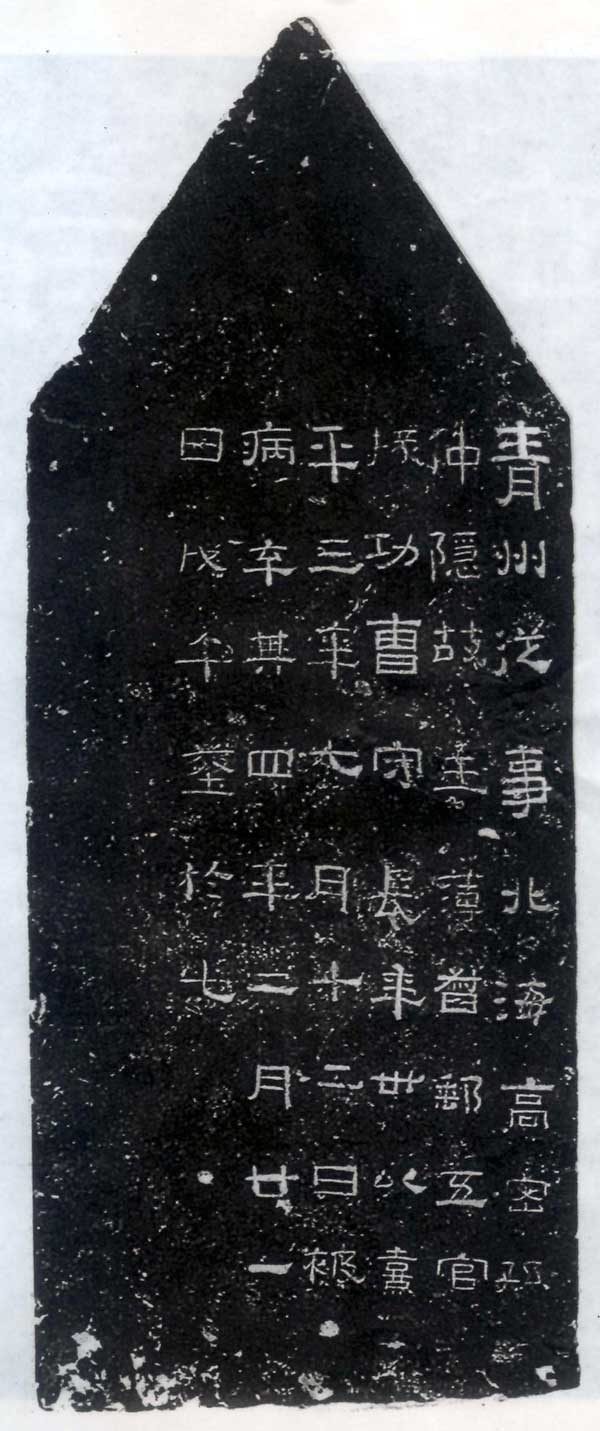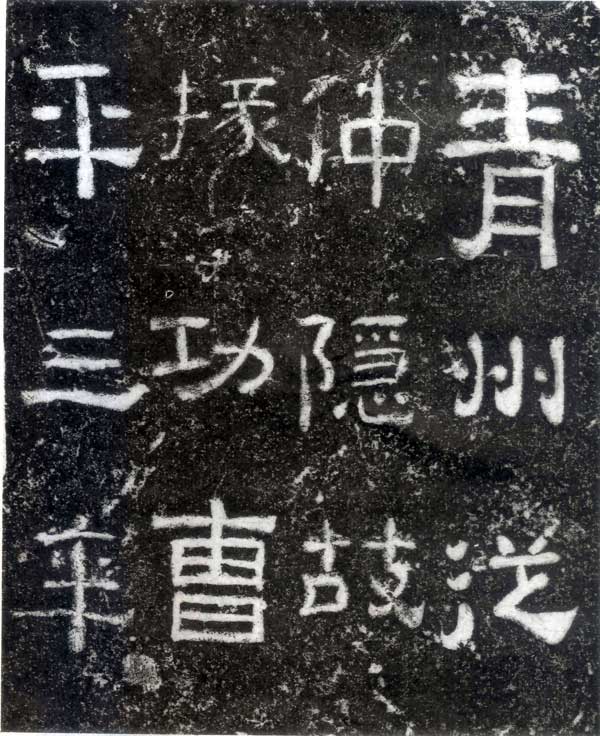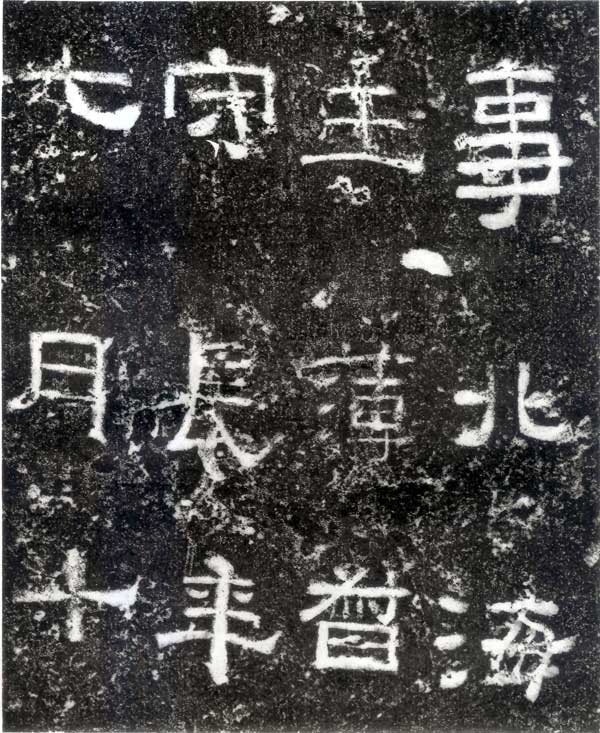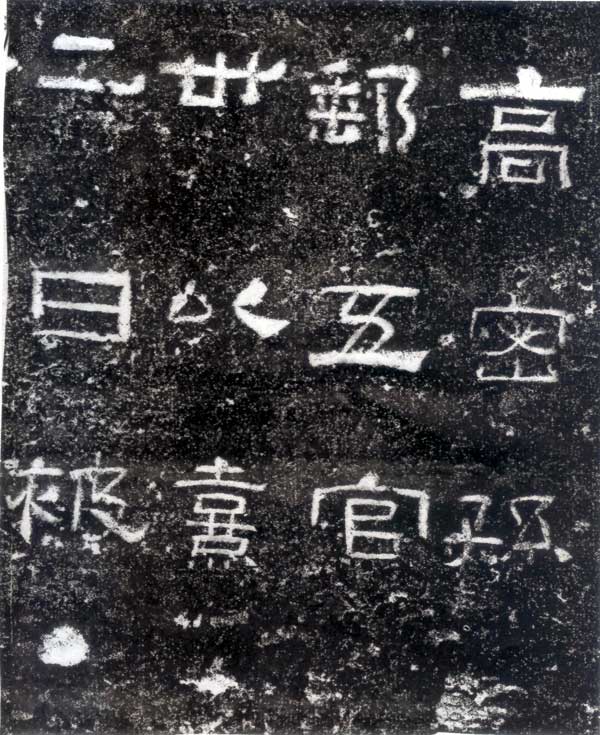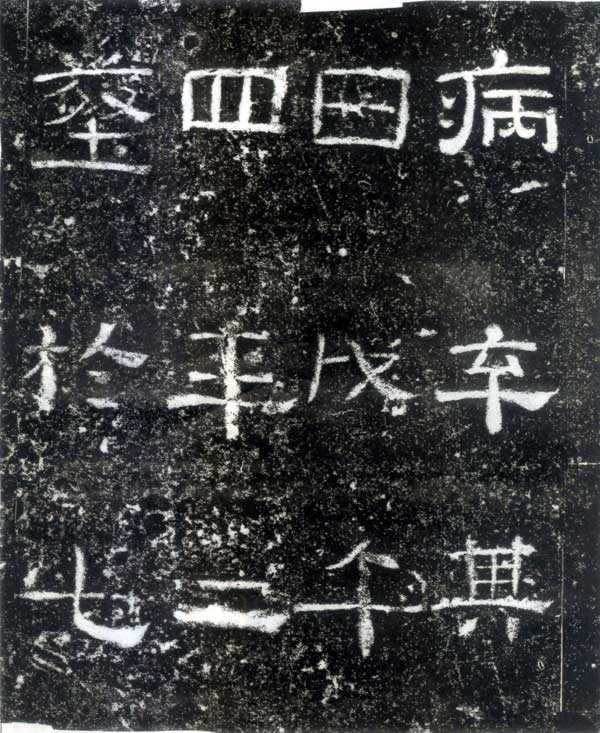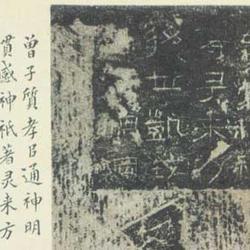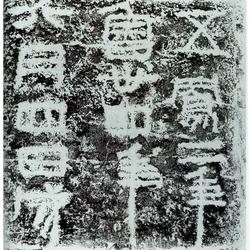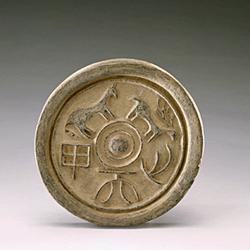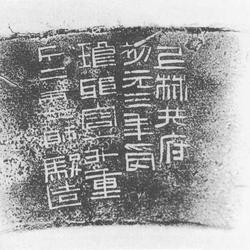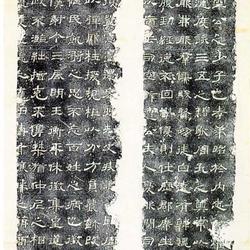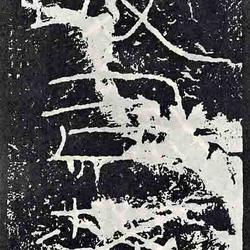In December 1983, Li Chusen and others from the Cultural Relics Management Office of Gaomi County, Shandong Province discovered a group of Han portrait stones embedded in the wall of the courtyard house at the east end of Wangzhuang Village, Shili Tianzhuang Township, southwest of the county. They were related to the Eastern Han Dynasty. There is a carved stone dating from the fourth year of Xiping (AD 175), Gui Shou, 88 centimeters high and 34 centimeters wide, with no inscription on the forehead. It has six lines of official script, each line has nine characters, and the text reads:
Working in Qingzhou, Sun Zhongyin, a high-density official in Beihai, became the chief bookkeeper, the postal supervisor, the five-function official, the meritorious official, and the chief guard. On the 30th year of his reign, he died of illness on July 12th in the third year of Yixi Dynasty. He was buried here on the 21st day of February in the fourth year of his reign.
Beihai Gaomi was under the Qingzhou Governor's Department at that time. The Qin Dynasty divided the Qin Dynasty and established Gaomi County, and the Han Dynasty Gaomi State was established during the reign of Emperor Xuan. During the Jianwu period of the Eastern Han Dynasty, Deng Yu was granted the title of Hou Yi and became part of the Beihai Kingdom.
The Sun family of Gaomi came after Bigan, the uncle of King Zhou of Yin. It was a powerful family in the Gaomi area at that time and was prominent in the world. "The Monument of Sun Gen, Prime Minister of Han'an" calls Sun Gen "the uncle of Sikong Gong, the brother of the prefect of Le'an, the prefect of Hanyang and the brother of Shi Yushi, and the test of Chengshi's order" (according to the tenth volume of "Li Yiang") -The so-called Sikong Gong is Sun Lang. "Book of the Later Han Dynasty: Records of Emperor Huan" records: "In the third year of Shui Shou, Sun Lang became Sikong in Beihai, Taichang." "The Names of Three Dukes of the Han Dynasty" also says: "Lang, a native of Gaomi, Beihai ." According to the twenty-seventh volume of "Li Shi": "The Monument of Sun Jun, Prime Minister of Han'an, is located fifty miles southwest of Gaomi County." The direction and mileage from the Epitaph of Sun Zhongyin to Gaomi County are consistent with each other (according to Gaomi County Placed in the sixth year of Wude (623), which is now Gaomi County), it is worth considering whether they belong to the same Han tomb group.
According to "Shandong Tongzhi" and field investigation, the location where the "Sun Zhongyin's Epitaph" was found is only five miles away from the site of the ancient city of Gaomi State in Han Dynasty. Langbu Ridge, three miles southwest of it, is the cemetery of the Gaomi royal family. According to local people, there were originally more than ten large tombs here. During the land preparation in 1958, they were leveled and sealed to be used as cultivated land. —In the afternoon of 1973, I stayed in a construction house in Wangzhuang Village. I used ancient tomb bricks and stones to open one of the tombs and found a stone door with portraits. The lintel of the door was engraved with a sheep's head pattern in relief. The tomb passage inside the door was also built with portrait stones. This stone is placed flat about one and a half meters inside the stone door. Gui's head faces the tomb door. Behind the stone, three crimson pottery horses more than half a meter high are placed. Because the villagers were confused by superstition, they did not dare to continue digging, and they did not dare to take out the pottery horse, so the tomb was about to be sealed. Only the thirty-eight portrait stones and this sign were removed and used for building houses. In March 1984, the stone was removed from the wall and transported to the Gaomi County Cultural Relics Management Office for preservation.
Based on the content and occurrence of the stone inscriptions, we can confirm that this is the epitaph of Burial You. Its shape is also the same as the "Inscription on the Coffin of Jia Chong's Wife Guo Huai" and the "Epitaph of Liu Tao" later.
As for the origin of the burial epitaph, previous metallurgists believed that according to historical records, in the 10th year of Jian'an (AD 205) at the end of the Han Dynasty, King Cao Cao of Wei was in power and banned thick burials and the erection of monuments. In the fourth year of Xianning (AD 278), Emperor Wu of the Western Jin Dynasty issued an edict banning the establishment of tables. So the carved stone was buried underground and became an epitaph. In modern times, underground cultural relics have been continuously unearthed, including "tomb inscriptions", "seals" and other carved stones. For example, "The Tomb of Jia Zhongwu's Wife Ma Jiang" was engraved in the first year of Yanping (AD 106) and the "Seal Notes of * Lin Weifu Tongbenzuo" signed in the sixth year of Yanxi (AD 162), etc. , these kinds of carved stones were all before Cao Cao banned the monument. Some people regard it as an epitaph, but some people have a negative attitude. For example, Mr. Ma Ziyun, in "A Brief Introduction to the Appraisal of Stele Inscriptions", said that the former "Although there are embryonic epitaphs, they are not real epitaphs, so they are called carved stones." The latter is listed in the table of "New and Old Forged Engravings of Different Generations". Ye Changchi said in "Yu Shi": "The tomb stones before the Han and Wei dynasties are not only unseen today, but also have no records in Europe and Zhao."
Regarding the beginning of the epitaph, there is no physical evidence to support it, so although there are different opinions, it is not certain in the end. The publication of "Sun Zhongyin's Epitaph" is the earliest Han Dynasty epitaph discovered in my country. It can be seen from this that the burial of secluded epitaphs has begun at least in the middle of the Eastern Han Dynasty. Judging from its content, "Sun Zhongyin's Epitaph" already has examples of epitaph writing. Moreover, it was unearthed from a destroyed tomb passage gate, so it was definitely not a tombstone that was re-buried in the soil. Although the tombstone erected by Sun Gen, who died six years later than Sun Zhongyin (i.e., the fourth year of Guanghe, AD - 81 AD), has been lost, according to the inscription recorded by Hong Shi of the Song Dynasty, not only did the inscription on the forehead of the stele read: "Han Anping Prime Minister Sun There are more than 600 characters in the upper part of the stele, and the names of the people engraved on the lower part of the stele can be identified, that is, 244 people. Some of them were crowned with titles, so the scale of this stele must not be very small. . It can be inferred from this that in the Eastern Han Dynasty when "stone tablets arose", Sun Zhongyin not only had a grand burial (guessed from the grand scale of the tomb passage) but also had his tombstone carved on the ground.
Han stele calligraphy can be divided into two major schools: official letters and private letters. Official books are written by famous scholars, such as "Kong Zhou", "Yi Ying", "Li Qi", "Shi Chen", "Cao Quan" and other steles, as well as "Xi Ping Shi Jing", etc., each with its own style in its uprightness. . Private letters were written by subordinate officials or lower-class intellectuals. Some calligraphers were not very well educated and occasionally made typographical errors when recording inscriptions, such as the "Zhang Qian Stele". In the Epitaph of Sun Zhongyin, the word "death" is written as "*" and the word "burial" is written as "*". The stipples are also wrong. In the Zhizhi, the character "B" for "disease" has a vertical hook and a vertical hook. The characters for "Wu" and "Yu" have pecking strokes for "人", indicating that the official script has begun to appear. This situation cannot be seen in the official books and steles at that time. However, precisely because the person who wrote the calligraphy was not a first-year student, he was less bound by the rules. If the characters are written casually and expressive, it is quite interesting and can be used as a reference for today's practitioners of officialdom.
